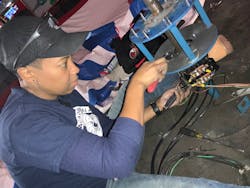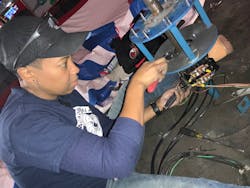As an electrical professional, you’ve probably resigned yourself to that fact that you’ll be working much longer than you originally expected, or maybe you've concluded that the kids won't be taking over your contracting business when you hit retirement age. For a number of reasons, we continue to have the same conversation we had five years ago when it comes to the skilled labor shortage and lack of people entering the trades. Yes, that number is growing, but it’s still not enough to cover the obvious gap.
The skilled labor force is shrinking in the electrical industry every year by thousands of electricians. The only way to solve this problem is to “reeducate” our society. In the past, vocational or trade schools seemed to be reserved for people who weren't cut out for the traditional four-year educational path. It’s no secret that college has been painted as the best pathway to success for generations, but that’s only true for some people.
Many students don’t want their future to be deferred without a clear pathway. What do we do about this situation? There’s no one answer that fits all, but here are some of my thoughts.
Talk to potential electrical professionals about the facts
As a society, we haven't done a good job discussing the opportunity costs of education versus vocational training. Even though many people who graduate from college make more money than those who do not, you still must factor in the overall cost of college, including compounded interest on student loans.
Let’s say you have a principal balance of $100,000 at an interest rate of 6%. With a monthly payment of $600, with no extra principal payments made, it would take you 30 years to pay off your debt! Factor in interest, and your total repayment cost would be $215,838.
On the other hand, the income and opportunities you give up by deferring your move into the workforce by four to six years can be substantial. For example, you could have made $35,000/year over the four years you spent in college, which equates to $140,000. Add to this the cost of your tuition ($215,000), and you’re looking at $355,000.
Vocational students who successfully transition into the building trades can make more money long-term because they have less debt, and they start their careers earlier than college students. College graduates who pursue careers as doctors, lawyers, accountants, and engineers are typically an exception and have a lower opportunity cost even with higher debt loads. But not everyone is cut out to be a doctor or lawyer.
We've been pushing reluctant kids to college for too long. For many, it’s a dead-end path as less than half of college students finish the degrees they start. A college acceptance letter isn't a guarantee of success or a path to a stable future.
School-age students should be exposed to a variety of paths that lead them to a successful future. That means they need to be exposed to vocational training early on. This could remove some of the negative stigma attached to choosing a vocational school over college.
Electricians are invisible to millennials
Does the neighbor's kid understand why you can take three vacations a year or buy a new truck every three years? Take more time to educate everyone around you in your inner circle as well as your community who is workforce ready. The average person thinks you have to be born with a unique skillset for the trades or that you need a relative to “let you into the business.” Invest the time it takes to dispel those myths, and explain to them that the legacy can start with them.
We’ve done a terrible job of making ourselves more visible and explaining what we do to the current generation of young workers. In fact, most people can’t even differentiate one type of tradesperson from another.
We are invisible to most of society, especially Generation Y and Z; they don't understand what we do or how important our jobs are in the construction industry. They’re also not aware of the financial freedom our trade has to offer, nor do they grasp how portable our skills are. We have expertise that can take us anywhere in the world; it’s not relegated to a desk and can even handle market swings during pandemics and recessions.
A call to action
So what do we do to bring about change? We must create more affordable, easy-to-access training programs for the trades; even if you have to launch a grassroots program on your own. Start small. The word will spread, even if it’s just a few students.
Align yourself with others interested in closing the skills gap. Talk to local contractors, supply houses, building inspectors, trade associations, or electrical inspectors. Do not seek approval; seek support and create awareness of your effort. Always have goals set for the future.
You can easily buy approved curriculums for training programs. Study existing training programs, and reach out to local colleges, churches, or schools to see if there is interest in partnering with you. Always seek diversity in your groups. Your goal should be to have a wide range of ages, genders, ethnicities, and religious affiliations. This is no longer a man’s trade.
How to get started
Find a curriculum first; maybe one approved by the state's apprenticeships or labor departments. Select a location for training; it can be in a church, a mosque, garage, school lunchroom, or civic association. Get everyone involved, but it's best to run the operation with a skilled, field-experienced tradesperson.
Here are a few things to consider before you start down this path. You may need child background clearances, depending on the age group and venue you launch your program in. This sometimes requires an FBI clearance, but the costs of these processes are insignificant.
Becoming a registered apprenticeship program takes time and money; it will require providing proof of local community support through letters and testimonials. It will also require patience and diplomacy.
If you look in the right places, there are millions of dollars in provincial and federal grants available. Perform online searches for local construction companies or registered contractors as approved apprenticeship program providers. Then call them, and ask questions.
Start with a long-term plan
Becoming an accredited school or program takes time and requires a lot of documentation online. Teaching requires patience — it's hard work. You have to convey clear pathways of understanding to your students and audience. That’s why it’s so much easier if you have personal field experience in the subject matter.
Always remember: Don't teach what you don't understand yourself. You have to create clear pictures of what's in your head. There's no guidebook for this pathway; find a mentor. EC&M, for example, has the support of an expert panel of teachers and industry experts. Don't be shy to reach out to anyone who may be able to help answer questions.
So, the bottom line is: The only way to close the skills gap is to get personally involved — because no one is coming to save us.
Follow my column for more practical how-to articles and tips on electric basics and applying those concepts in the field, such as The Apprentice’s Guide to NEC Chapter 4, Everyday Instructions for Electricians, Introduction to Commercial Service Calculations, Introduction to Residential Service Calculations, The Apprentice’s Guide to Non-Metallic Sheathed Cable, and Introduction to the NEC. For more in-depth information on why a structured approach is so important to navigating the NEC and how to put its requirements into practice in real-world settings, read “The NEC for Newbies.”
Harold De Loach, a master electrician and electrical trainer/instructor, is the founder of The Academy of Industrial Arts (www.taia-school.com) in Philadelphia. With more than 30 years of experience in the field, he writes regular exclusive content for the E-Train and can be reached at [email protected].
About the Author
Harold De Loach
De Loach is the Director of Education and Training for the Leaders of Electrical License Preparation courses for Philadelphia and The Lehigh Valley (www.necprepclass.com). He is the founder and Director of The Academy of Industrial Arts L.L.C. (www.taia-school.com), a customized electrician training program that provides entry-level electrician training courses, electrical safety classes and customized electrical construction courses. He is trained by the National Center for Construction Education and Research (NCCER). He is a member of The National Society of Collegiate Scholars, the Independent Association of Electrical Inspectors, the Electrical Association of Philadelphia, and the Better Business Bureau.
His level of knowledge affords him to teach entry, intermediate, and master level electricians. Armed with more than 20 years of experience in the electrical, general construction, and real estate development industry, he offers his students and clients several unique skill sets. He has worked as the Head Craft Instructor and Assistant Director of Education at the Apprenticeship Training Center (affectionately known as The ABC School) in Harleysville Pennsylvania for Associated Builders and Contractors (The South-Eastern Pa. Chapter). Prior to Joining ABC, he directed a work-readiness (Re-Entry) Construction Technology program within The Philadelphia Prison System and as an Electrical Technician Program instructor at Kaplan Career Institute (Formerly Thompson institute) in Center City Philadelphia and Franklin Mills. He is available for consultation, private tutoring, speaking engagements, or strategic partnerships that can bolster the number of new electricians entering the industry.


